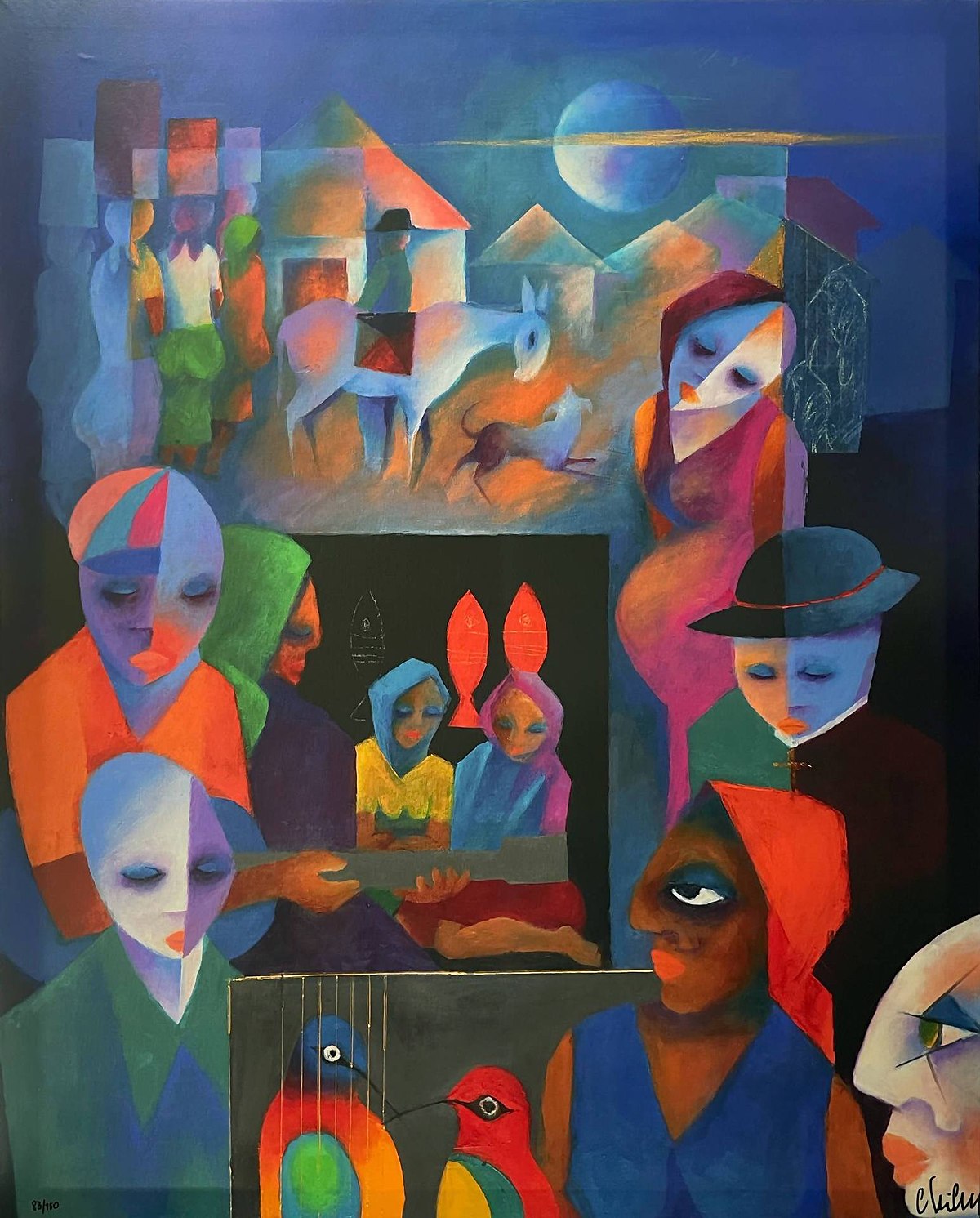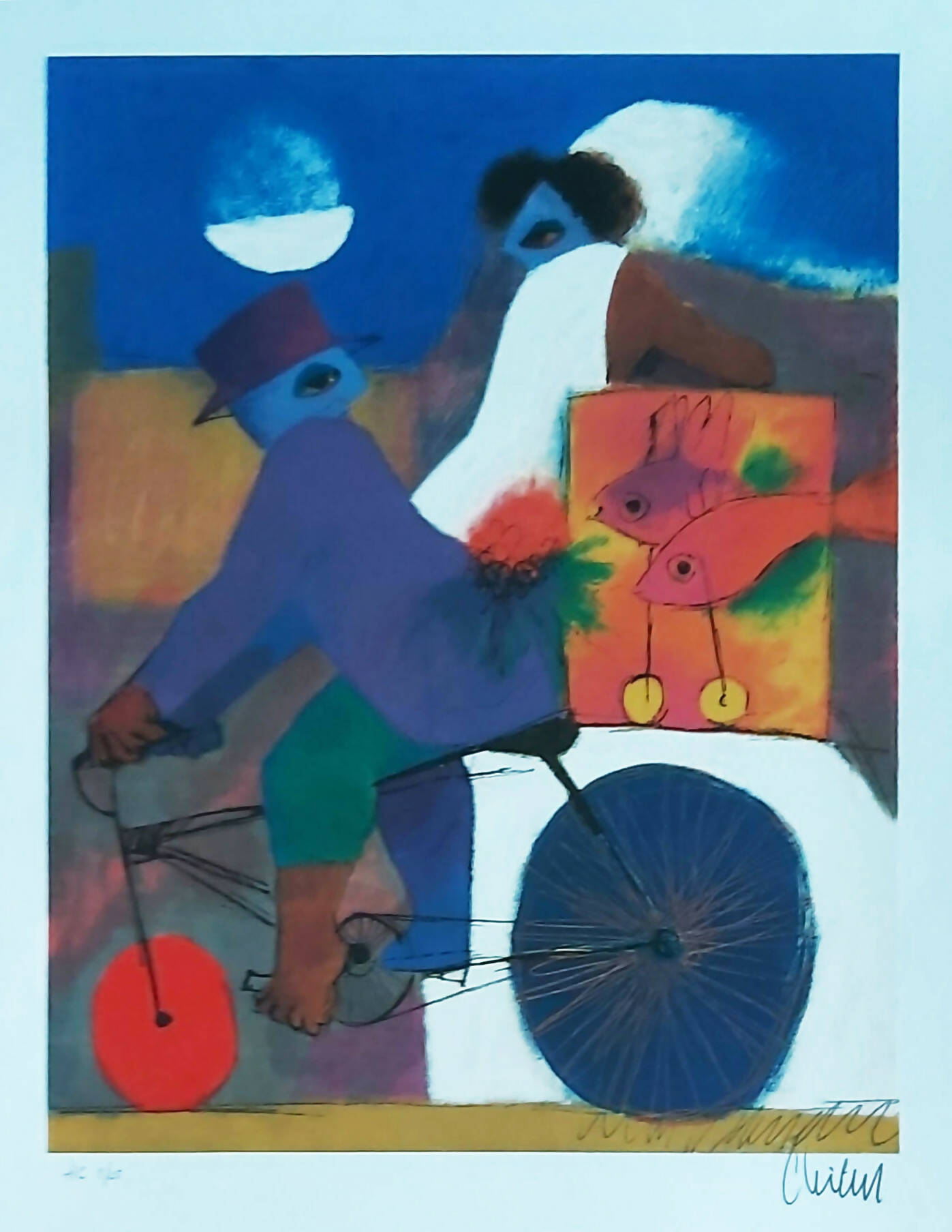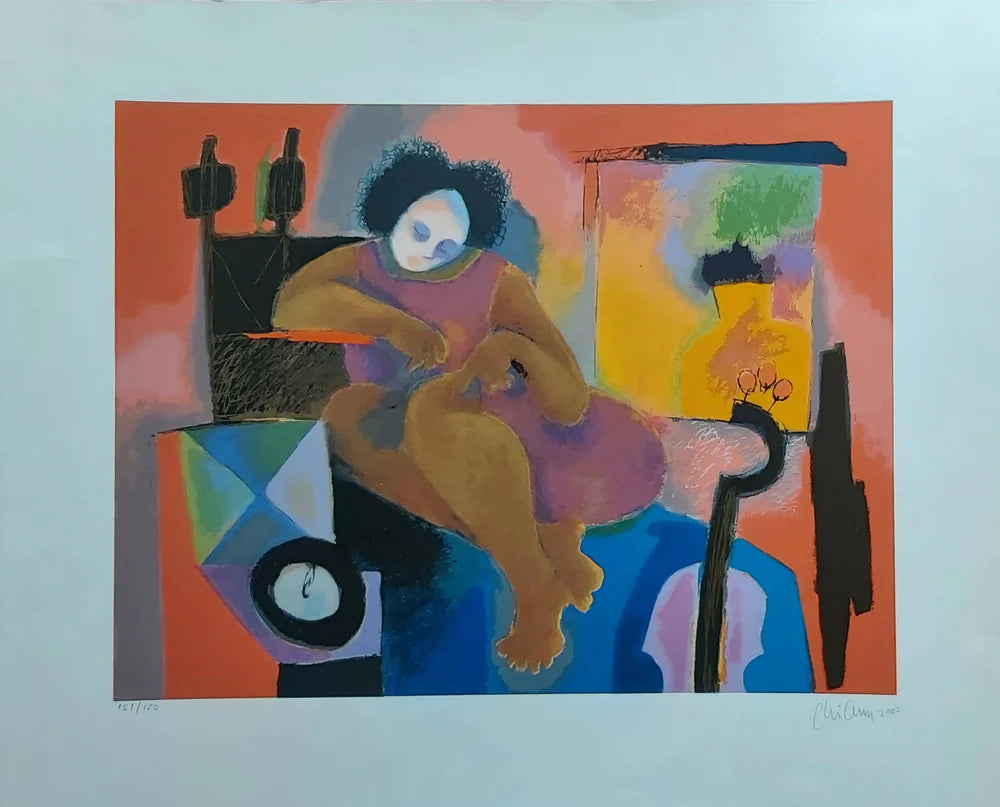
Roberto Chichorro (Mozambique, 1941) is a name that resonates vibrantly in the artistic scene, a true master of colors and shapes who has left an indelible mark on contemporary art. Roberto Chichorro he followed a unique path, where the color palette merged with his childhood memories in vibrant Mafalala, a neighborhood that served as a bridge between two distinct cultures in a time of transformation.
Although he initially pursued a career in construction, his passion for art soon led him to explore the world of illustration, painting and set design. His artistic trajectory began to shine brightly at the exhibitions in Lourenço Marques (now Maputo) in the 1960s, and since then, his work has captivated hearts all over the world.
Roberto Chichorro is an artist who transcends geographic and cultural boundaries, with works that radiate vibrant colors and exuberance, capturing both the turbulent history of Mozambique and the vitality of the African people. His paintings not only narrate the armed struggle and social repression that marked crucial times, but they also evoke a magical, almost imponderable world, full of dreams and enchantment.
In this article, we will delve into the depths of the life and work of this talented Mozambican artist, exploring his journey from his earliest childhood to his consecration on the international stages of contemporary art. Through the colors and brushstrokes of Roberto Chichorro, we will discover a universe of poeticity and dreaminess that invites us to dream, imagine and understand the complexity and beauty of the African continent, captured by the sensitive gaze of a true master of painting.
What are the characteristics of works by Roberto Chichorro?
The works of Roberto Chichorro are marked by a series of distinct characteristics that contribute to the uniqueness and impact of their work on contemporary art. Here are some of the main characteristics of his works:
Vibrant use of colors: One of the most distinctive features of Roberto Chichorro is the bold and vibrant use of colors. It incorporates a rich and intense palette, often with sharply African tones, which capture the vitality and exuberance of African cultures.
Figurativism, abstraction and visual narrative: Roberto Chichorro He skillfully navigates between figurativism and abstraction in his works. His paintings often feature figurative elements, such as people, animals and objects, but they are often stylized and transformed into abstract forms that add a touch of surrealism and imagination to his creations. Many of the works of Roberto Chichorro tell stories and visual narratives. He uses his art to explore historical, social and cultural themes, conveying deep and emotional messages through his compositions.
Representation of African culture, Magical and dreamlike influences: Many of the works of Roberto Chichorro have a strong connection with memory and history, both personal and collective. It portrays significant moments in the history of Mozambique and Africa, as well as his own childhood experiences and memories. Roberto Chichorro He has a deep connection with African culture and his works often portray aspects of African life, traditions and rituals. He celebrates the richness and diversity of African cultures in his art. The artist often incorporates magical and dreamlike elements into his paintings. These elements can include mysterious symbols, dreamlike images, and scenes that seem straight out of fairy tales or African myths.
Fusion of cultural influences: His work is a fusion of diverse cultural influences, including African, European and Mozambican elements. This mix of cultures is evident in his eclectic compositions and the diversity of themes covered.
Emotional expression: The paintings of Roberto Chichorro They are full of emotion and feeling. It uses color, shape and texture to convey a wide range of emotions, from joy and hope to melancholy and introspection.
Varied technique: Roberto Chichorro is a versatile artist who employs a variety of techniques in his works, including oil painting, watercolor, ceramics and zinc engraving. This technical diversity allows him to explore different styles and artistic expressions.
What are the recurring themes in the works of Roberto Chichorro?
African Culture: One of the central themes in the works of Roberto Chichorro It is the celebration of African culture. It portrays aspects of African life, traditions, rituals, dances and music, highlighting the richness and diversity of the continent's cultures.
Memory and History: Roberto Chichorro it often incorporates elements related to memory and history, both personal and collective. His paintings can evoke memories of his childhood in Mozambique, as well as significant historical moments in the region and the African continent.
Everyday Scenes: Roberto Chichorro portrays scenes from everyday African life, capturing common moments in people's lives, such as workers, musicians, dancers and families. It gives importance to everyday life and the authenticity of African experiences. Music and dance are frequent themes in his paintings, capturing the joy and artistic expression that play a fundamental role in African culture.
Repression and Struggle: Some of his works address darker themes, such as social repression and the fight against oppression, especially in relation to the turbulent times in Mozambique and other African countries during the colonial and post-colonial era.
Nature and Environment: In some of his works, he portrays African nature, including landscapes, animals and natural elements. This reflects its connection with Mozambique's natural environment and the importance of nature preservation.
How did the history of Mozambique influence Robeto Chichorro's work?
The history of Mozambique played a fundamental role in influencing and inspiring the work of Roberto Chichorro. As a Mozambican, he lived and witnessed historical events and significant social transformations in his country, elements that are notably reflected in his art.
Roberto Chichorro grew up in Mozambique during the Portuguese colonial period, a time characterized by oppression, racial segregation and profound social inequalities. This experience left a profound mark on his perception of social injustice, becoming a recurring theme in many of his works. Furthermore, Mozambique went through a period of struggle for independence in the 1960s and 1970s, with many Mozambicans mobilizing against Portuguese colonial rule. Roberto Chichorro He lived through this turbulent time and his art often addresses themes related to the struggle for independence and resistance, capturing the courage and determination of the Mozambican people. Roberto Chichorro seeks to preserve and transmit the country's history through its works, remembering important events and paying homage to historical figures who played significant roles in Mozambique's trajectory.
Mozambique is a country where several cultural influences meet, including African, European and Asian. Roberto Chichorro captures this mix of influences in his paintings, creating works that reflect the fusion of cultures and the unique diversity of Mozambican society.
Furthermore, Mozambique's stunning natural landscapes, as well as popular culture and people's everyday experiences, serve as constant sources of inspiration for Chichorro, who portrays them with vibrant colors and vivacity in his paintings.
In short, Mozambique's rich and complex history is an undeniable influence on the work of Roberto Chichorro, shaping his works as a vibrant expression of the country's cultural identity and diversity, while also addressing crucial social and political issues that have marked the nation throughout its history.
What are Robert Chichorro's favorite painting techniques?
Oil painting: Oil painting is one of the most traditional and popular techniques in his work. Roberto Chichorro He uses oil on canvas to create many of his most iconic paintings. This technique allows for great flexibility in mixing colors and creating textures, which fits well with the vibrant color palette he usually uses.
Watercolor: Watercolor is another technique that Roberto Chichorro explored in his work. Watercolor is known for its transparency and fluidity and the artist uses this technique to create paintings with water effects and soft colors.
Ceramics: Roberto Chichorro He worked on ceramics during his time in Madrid, Spain, as a grant from the Spanish government. He collaborated with Taller Azul, exploring ceramics as an artistic medium. This technique allows you to create sculptures and three-dimensional objects, adding a sculptural dimension to your artistic expression.
Zinc engraving: In addition to ceramics, Chichorro also explored the zinc engraving technique while in Madrid. Zinc engraving involves engraving a zinc matrix to create engravings and illustrations. It is a technique that offers precise details and distinct textures.
Mixed Techniques: Roberto Chichorro He is also known for combining different techniques in his works. For example, you might start with watercolor and add oil details or incorporate ceramic elements into a painting. These combinations create unique and surprising results.
Collage: In some of his works, Roberto Chichorro incorporates collage elements. You can include newspaper clippings, photographs, or other materials to add layers of meaning and texture to your compositions.
Experimental Techniques: Roberto Chichorro He is an artist who likes to experiment. You can use less conventional techniques and explore new means to create interesting visual effects in your paintings. The variety of techniques that Chichorro uses in his work demonstrates his versatility as an artist and his willingness to explore different means of artistic expression. This enriches his work and contributes to his ability to convey a wide range of emotions and ideas in his paintings.
What is the legacy of Roberto Chichorro in the contemporary art scene?
The legacy of Roberto Chichorro in the contemporary art scene is deeply impactful and diverse. His influence is not just limited to his art, but also encompasses his commitment to the preservation of African culture and his role as an ambassador for Mozambican art.
Through your work, Roberto Chichorro promoted the cultural and ethnic diversity of Mozambique and the whole of Africa, emphasizing the importance of preserving and valuing African identity in a world in constant transformation. His paintings also function as historical records, documenting crucial events in Mozambique's history and keeping alive the memory of the country's struggles and achievements.
Roberto Chichorro played an influential role in the contemporary African art scene, inspiring other artists to explore cultural, social and political themes in their own works. His innovative artistic approach and commitment to authenticity opened doors to new forms of expression in contemporary African art.
Furthermore, it promoted cultural dialogue between Mozambique and other countries through exhibitions and international collaborations. This enriched mutual understanding between different cultures and brought the richness of Mozambican culture to a global audience.
The work of Roberto Chichorro continues to inspire young artists in Mozambique and across Africa, serving as a role model for those who wish to make significant contributions to the contemporary art scene.
In addition to his artistic contribution, Roberto Chichorro He has also excelled in social activism and humanitarian causes, using his influence and voice to address crucial issues such as social justice and human rights.
The legacy of Roberto Chichorro is a notable contribution to the contemporary art scene, marked by its dedication to authentic artistic expression, its celebration of African culture and its commitment to preserving the history and memory of Mozambique. His influence transcends borders, leaving a lasting mark on art and culture.





